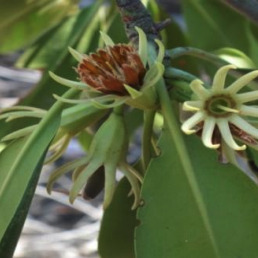Small tree up to 10 m by 25 cm. Bark dark-grey and cracked. Leaves obovate, rarely elliptic, 5-9.5 by 3-4.5 cm, acute, base acuminate, margin sometimes revolute; nerves 7 pairs, distinct; petiole 1½-2½ cm. Stipules c. 2 cm long. Peduncle 7-12 mm. Flowers at anthesis 2-2.5 cm long. Calyx 8(-10)-lobed, 10-15 mm long, tube distinctly ridged externally down to the base. Petals 9-11 mm long, densely fringed with white appressed hairs at the base and along the outer margins, lobes 1h the length of the petal, obtuse, without bristles at the apex and in the sinus, very rarely with a minute, obscure one in the sinus. Filaments 10 mm, anthers 5 mm long, apiculate. Style c. 14 mm long, stigmas obscurely 3-lobed. Hypocotyl cylindric, obtuse at both ends, obscurely ridged, 4.5-6 cm by 6-8 mm.
Tree to 10 m high, buttressed; bark fissured, grey; knee roots present. Leaves: lamina usually obovate, acute, 4–10 cm long, 2–5 cm wide, margin often recurved; petiole 1.5–2.5 cm long; stipules c. 2 cm long. Flowers solitary, 2–2.5 cm long at anthesis; pedicels 7–12 mm long. Hypanthium distinctly ridged throughout, tapering to base. Sepals 8, occasionally to 10, leathery. Petals 9–11 mm long, shortly 2-lobed; base and margins densely villous; bristles absent, or a minute one in sinus only. Anthers 5 mm long, apiculate. Hypocotyl cylindrical, slightly ridged, 4–6 cm long, 6-8 mm wide.


